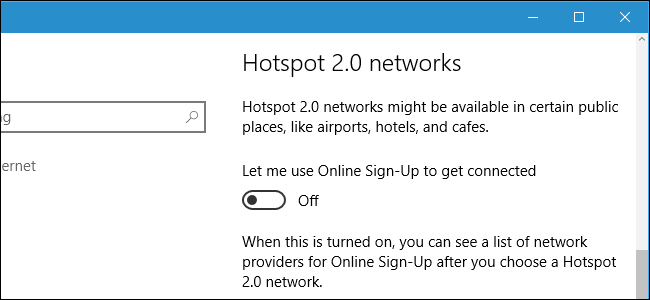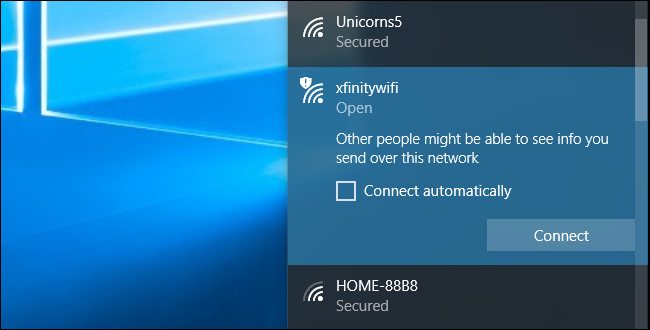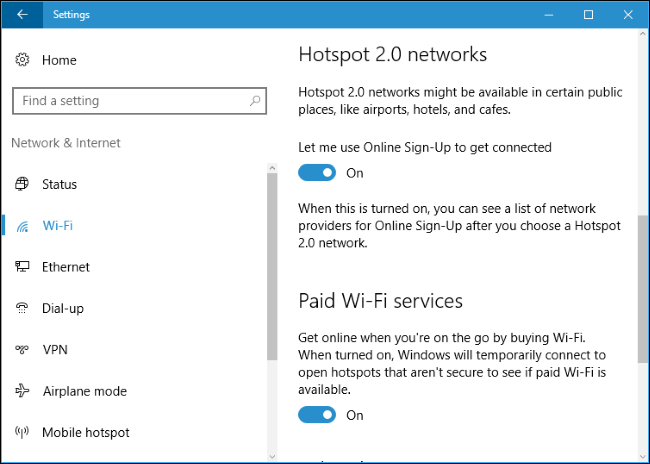Quick Links
Hotspot 2.0 networks are a new wireless standard designed to make it easier and more secure to connect to public Wi-Fi hotspots. They're supported in the latest version of Windows 10, macOS 10.9 or newer, Android 6.0 or newer, and iOS 7 or newer.
How Hotspot 2.0 Networks Work
The goal of Hotspot 2.0 networks is to provide cellular-style "roaming" for Wi-Fi networks. As you move around the world, your device will connect you to available public hotspots automatically. There are a few benefits to this:
- Public Hotspots Become Easier and More Secure: When you visit an airport or coffee shop, your device will automatically know which is the real public airport Wi-Fi network and connect automatically. You don't have to guess whether "FREE_AIRPORT_WIFI" is the real network, connect manually, and click through a sign-in screen.
- Network Providers Can Band Together: Hotspot 2.0 networks are designed to work better when service providers partner with other providers. Let's say, for example, you have Comcast Xfinity internet at home, which includes access to Xfinity Wi-Fi hotspots around the country. The goal is for Comcast to partner with other hotspot providers, so Comcast customers could get online on other hotspot provider networks and other companies' customers could get online at Comcast hotspots.
- Encryption is Mandatory: Many current public Wi-Fi hotspots are open Wi-Fi networks, which means people can snoop on your browsing. Hotspot 2.0 networks require enterprise-grade WPA2 encryption.
Some companies call this feature "Passpoint" or "Next Generation Hotspots" instead. On a technical level, it's based on the 802.11u Wi-Fi standard.
How to Use Hotspot 2.0 Networks
Hotspot 2.0 networks are designed to be simple to use. For example, Time Warner has rolled out Hotspot 2.0 support to its network of Wi-Fi hotspots. To connect to one, you just click the "TWCWiFi-Passpoint" hotspot in the list of nearby Wi-Fi networks and tell your device to connect. You'll then see a login screen where you have to provide your Time Warner Cable login details. After you sign in once, your device will automatically connect to affiliated Passpoint networks in the future.
Providers can also offer you profiles ahead of time. For example, Boingo offers a Hotspot 2.0 profile that will connect you to affiliated hotspots in a variety of airports. Install this profile using your browser and your device will automatically connect to those hotspots when you visit those airports.
Whether you just connect to a Hotspot 2.0 network or install profiles ahead of time, it's designed to "just work". Windows 10 offers an "Online Sign-Up" feature that will present you with a list of network providers when you try to join a Hotspot 2.0 network for the first time. After you set it up once, your device will automatically connect to other Hotspot 2.0 networks in the future.
Hotspot 2.0 Isn't Widespread Yet, But It's Getting There
This technology is still new, and most of the Wi-Fi hotspots you come across won't be Hotspot 2.0-enabled. But, if you've installed a profile from your provider and you're in range of a Hotspot 2.0 network, you'll be connected automatically. If you try to connect to one without setting up a profile first, the Online Sign-Up feature will help you get connected.
Hotspot 2.0 networks are available in many US airports. Time Warner Cable has already enabled Hotspot 2.0 capabilities, while Comcast is working on it. New York City's LinkNYC Wi-Fi hotspots also use Hotspot 2.0 technology.
These networks are already out there, but it will take some time for Hotspot 2.0 networks to gain the wide coverage necessary to replace the older network of one-off hotspots in airports, hotels, parks, malls, and other public locations. People shouldn't have to learn anything new to connect to these networks: The experience should just get better.



